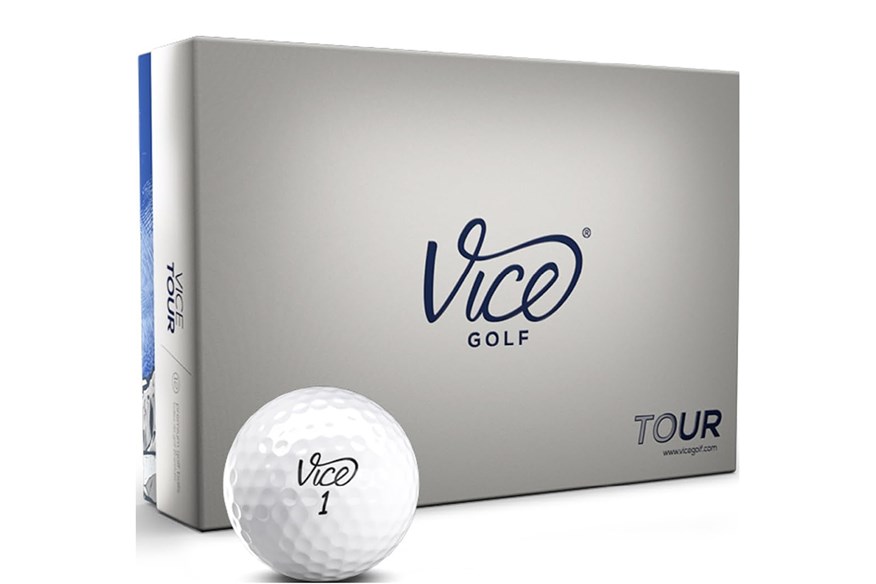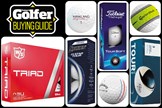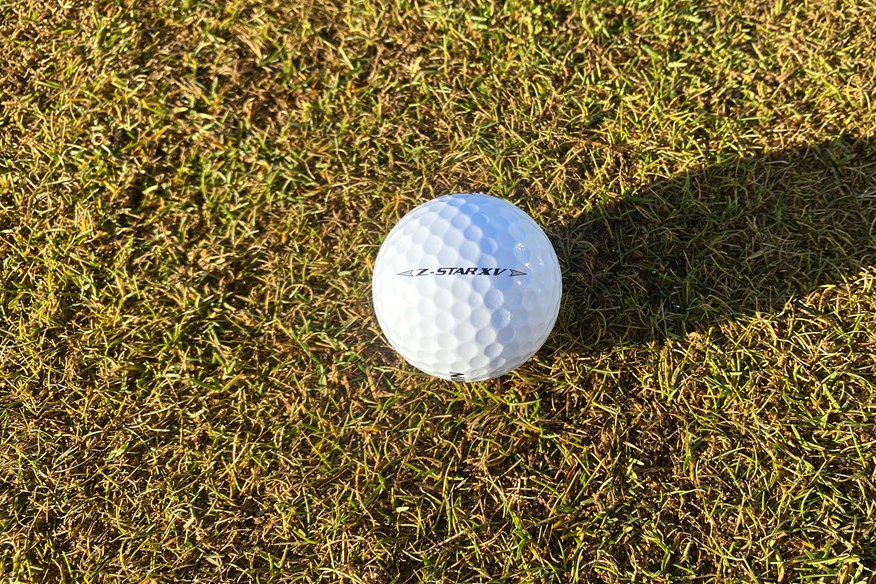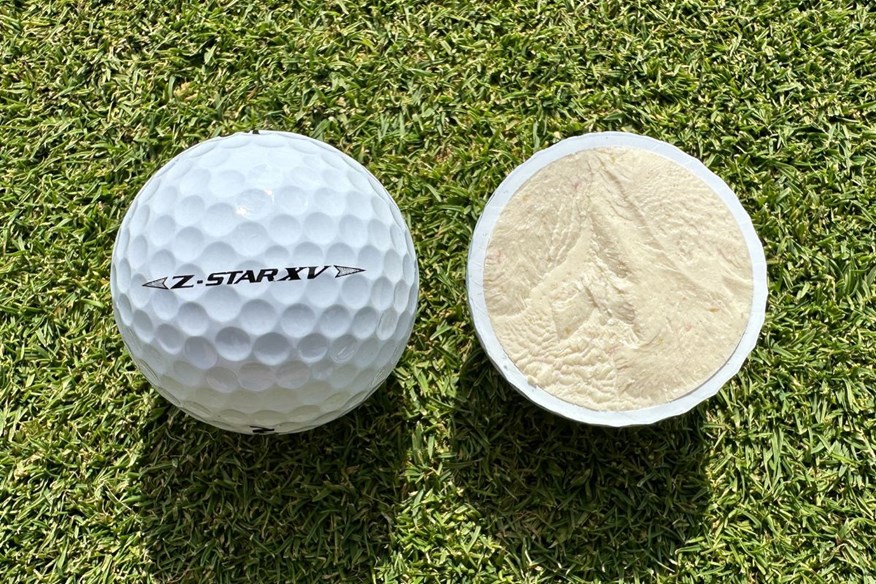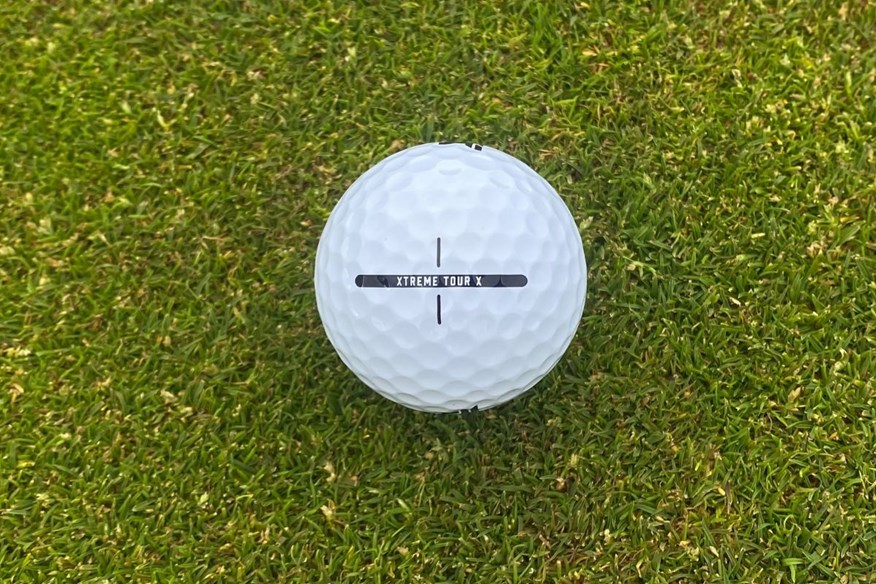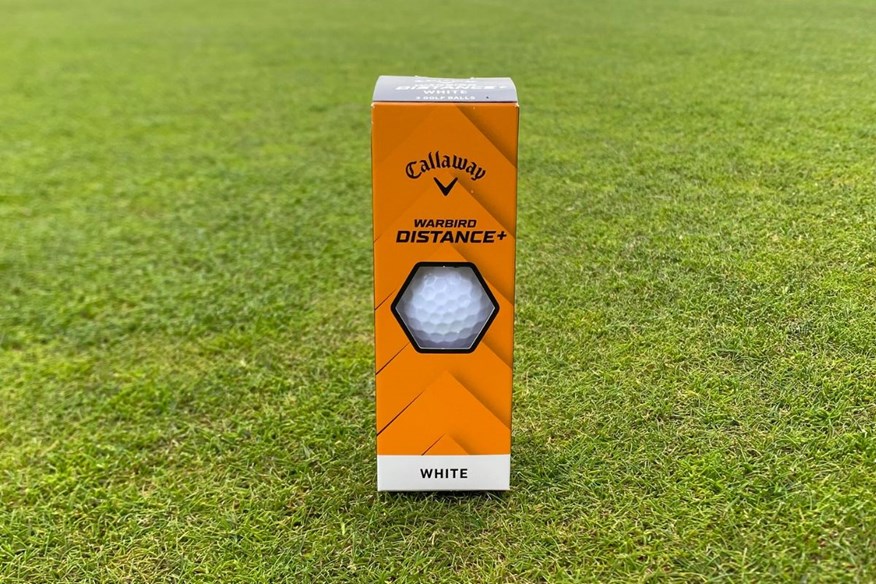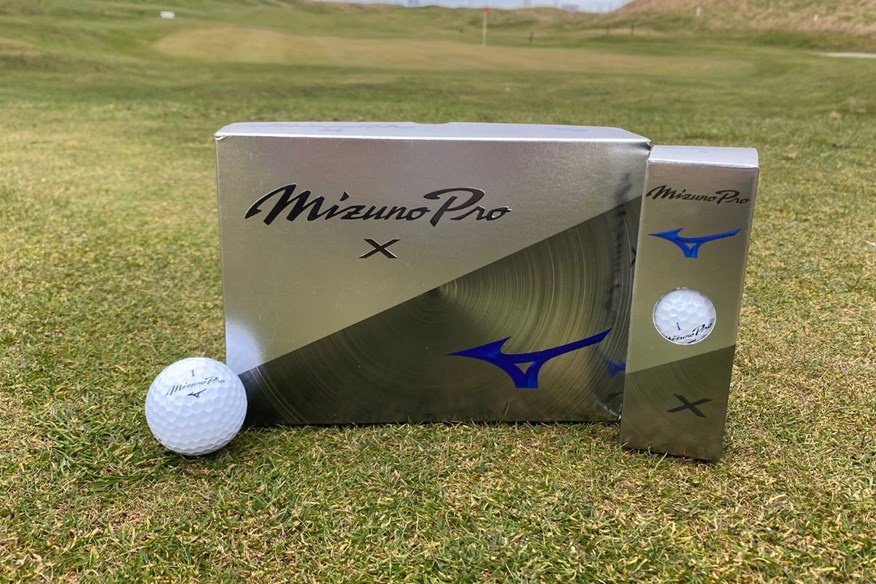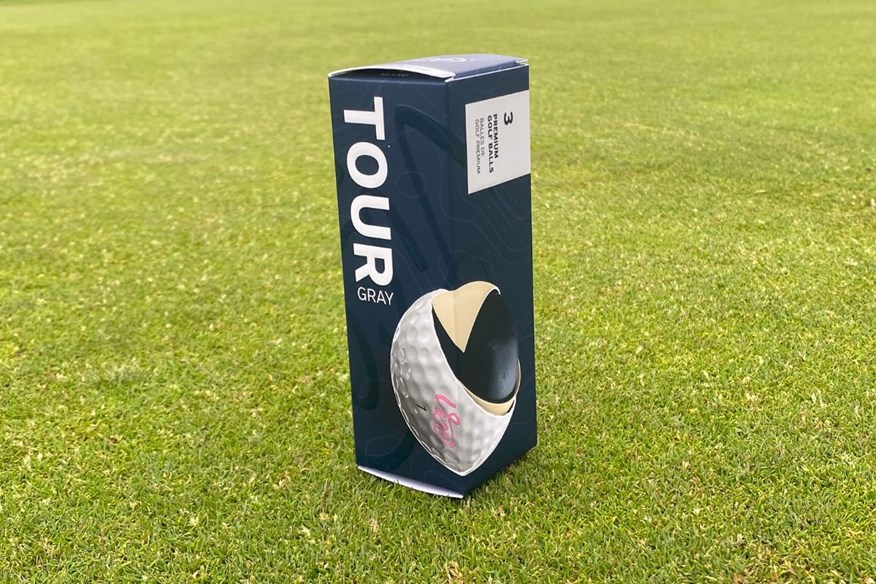Best golf balls for mid-handicappers 2025: Tested on an R&D robot and on-course
Last updated:
Click below to find out more about Today's Golfer's golf ball testing process.
Just so you know, we may receive a commission or other compensation from the links on this website – read why you should trust us.
We’ve tested the most popular and most-played golf balls on an R&D robot and on-course to help you determine which is the best golf ball for mid-handicappers
Jump to:
- At a glance
- Best golf balls for mid-handicappers
- Robot test data
- Buying guide
- FAQs
- What to read next
Whether you are an amateur golfer who continuously plays to a decent level or an amateur golfer aspiring to lower your scores, you need to know what the best golf balls are for your game. We’ve tested 62 golf balls on an R&D robot to determine which is the best golf ball for mid-handicappers.
Obviously, golf balls for mid-handicappers cover a wide range of golfers including men, women, and those who play with the best golf balls for beginners and high handicappers. However, these golf balls are suggestions for amateurs who want to score well and play with a high-quality golf ball, but not pay the premium price tag.
Best golf balls for mid-handicappers: At a glance
This is a relatively new category of golf balls which sees a merger between the best premium golf balls and the best two-piece golf balls. Almost all of the top brands have an option in this category. Whether you normally play with Titleist, Srixon, or Callaway golf balls, there’s a fantastic model to choose from here.
These golf balls probably appeal to more golfers than any – but not many people will assume so – especially after the news of the golf ball rollback definitely happening. As a mid-handicap golfer, you might want to increase distance or greenside spin and control. To better understand which will benefit your game, it’s worth checking out the best golf balls for spin.
- 2025 golf ball robot test: 62 golf balls, 2,232 shots, 50,000 data points… find out what’s No.1 for you
- How we test golf equipment at Today’s Golfer
If you’ve never used a golf ball from this category, the choice can be difficult, especially with so many options being among the best value golf balls you can buy. Therefore, I have compiled the following list with a range of options to suit every golfer’s needs and wants. Hopefully, you can make a sound, informed decision to help you play to the best of your ability.
Once you’ve looked through the best mid-handicapper golf balls, to help you with your decision, read through the detailed buying guide and have any questions answered in the FAQ section. Also, you might want to partner your golf balls with one of the best drivers for mid-handicappers and best irons for mid-handicappers.
Best golf balls for mid-handicappers
The most dominant 3-piece Tour-level golf ball
Best overall golf ball for mid-handicappers



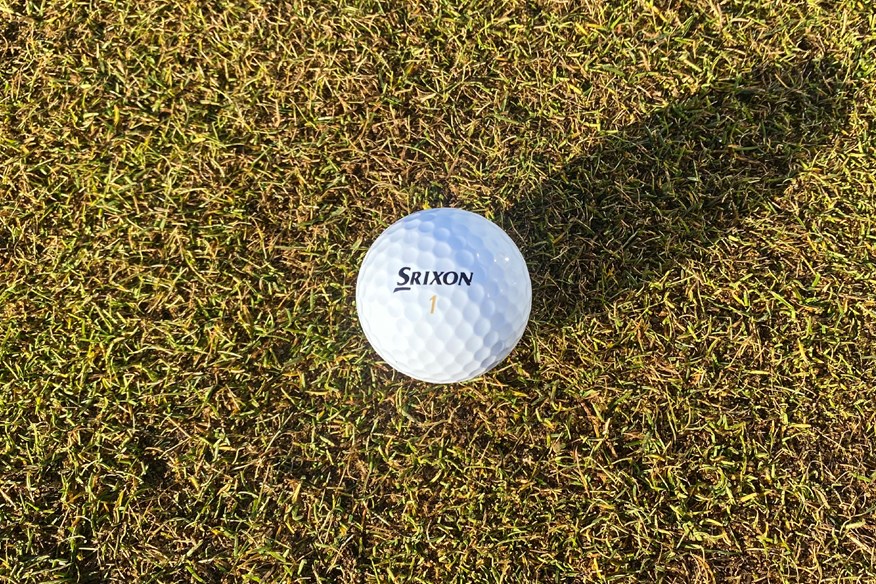


The Srixon Z-Star Diamond is one of the best high-spin golf balls. This golf ball was initially designed for Brooks Koepka, but it's become more popular among other Srixon staffers and amateur golfers. Based on our 2025 robot test results, it's clear to see why!
The Z-Star Diamond won an award in every category, barring one (off-the-tee performance), but where it did rank, it took the top spot. Let's have a quick run through the Z-Star Diamond's awards: gold medal for tee to green performance at 114mph, 93mph, and 78mph, gold medal for approach play, and gold medal for short-game performance.
Around the greens, the Z-Star Diamond is the best three-piece Tour-level golf ball you can play, and the second-best golf ball of all 62 tested, generating 6,137rpm backspin at the 40-yard pitch shot.
However, it's unlikely you'll miss the green in the first place! The Z-Star Diamond is the best golf ball for firing at pins. This golf ball ranks second for descent angle (45.3°), fourth for carry distance consistency, and third for backspin (5,149rpm - one of only three golf balls with over 5,000rpm). This is a recipe for success when you're attacking pins.
The Z-Star Diamond is a consistent golf ball off the tee at all three driver swing speeds. So, whether you swing like Koepka or not, this golf ball will deliver strong numbers for your swing speed. The Z-Star Diamond is above the test average for ball speed and carry distance at all three driver swing speeds.
This golf ball cleaned up in the three-piece Tour-level category! The Z-Star Diamond has to be on your mind if you're looking for a new golf ball.
On-course verdict
The Srixon Z-Star Diamond delivers the optimal performance out of the three golf balls in the 2025 Z-Star range.
The Z-Star Diamond is brilliant if you’re looking for one of the best high-spin golf balls because it’s very easy to generate spin with this model. That being said, it’s definitely lower-spinning off the tee than the previous generation.
I’ve tested a heap of outstanding Tour-level golf balls over the past couple of years, but I don’t think any have impressed me as much as the Z-Star Diamond on approach shots.
If you think a golf ball that travels far and spins high sounds right for your game, then you have to try the Z-Star Diamond, regardless of your ability.
I absolutely love how this golf ball feels off every club face in my bag. I wouldn’t necessarily say it’s particularly firmer than the Z-Star or Z-Star XV, but I think the feedback is much stronger. Thanks to the solid feedback, the response is very satisfying on well-struck shots, but not so much when the contact isn’t as good. However, I think that’s what makes a good golf ball.
Of all the golf balls I’ve played with over the past couple of seasons, this is without a doubt the best-performing golf ball from tee to green.
The Z-Star Diamond performs optimally in every area, which makes it extremely difficult to criticize. It feels great, feedback is amazing, and performance is extraordinary.
I don’t know what more a golf ball can offer!
Read our full Srixon Z-Star Diamond golf ball review.
Pros
- Amazing control from tee to green
- High spinning in the iron and short game
- Fantastic feedback and response
Cons
- High-spinning nature does slightly hinder distance
| Carry distance (yds) | Driver 114mph - 270.7 | Driver 93mph - 207.8 | Driver 78mph - 161 | 7-iron - 153.1 |
| Ball speed (mph) | Driver 114mph - 163.6 | Driver 93mph - 133.8 | Driver 78mph - 113.1 | 7-iron - 108.7 |
| Backspin (rpm) | Driver 114mph - 2,988 | Driver 93mph - 2,838 | Driver 78mph - 2,719 | 7-iron - 5,149 | Pitch - 6,137 |
| Launch angle (°) | Driver 114mph - 11.2 | Driver 93mph - 12.5 | Driver 78mph - 13.6 | 7-iron - 20.5 | Pitch - 30 |
| Descent angle (°) | Driver 114mph - 39.4 | Driver 93mph - 32.6 | Driver 78mph - 28.1 | 7-iron - 45.3 | Pitch - 35.1 |
| Peak height (yds) | Driver 114mph - 34.5 | Driver 93mph - 22.4 | Driver 78mph - 15.7 | 7-iron - 29.3 | Pitch - 6.5 |
| Compression (psi) | 106 |
- Speed dimple pattern
- Thin premium Biomass cover
- Spin skin+ coating
- Fastlayer DG core 2.0
- 338 dimples
- 3-Piece construction
- Available in white and yellow
Gold medal for tee to green performance at all three driver swing speeds, off-the-tee performance, and approach play performance
Let's start by running through all of the e12 Speed's awards. Gold medal for tee to green performance at 114mph, 93mph, and 78mph, off-the-tee performance, and approach play performance.
The only area where the e12 Speed didn't rank is short game performance, where it finished in fourth, by 9rpm (5,951).
The e12 Speed is the highest-performing Bridgestone golf ball, factoring in how it performed in every area. Its best performance has to be off the tee. At 114mph, this golf ball was 2.4 yards longer and 0.8mph faster than the second-longest and second-fastest model, and fourth-longest overall (273.9yds).
At 93mph, the e12 Speed is the second longest (209.7yds) and fastest (134.1mph) 2-piece golf ball. But, at 78mph, this golf ball is back at the top of the table for both (161.3yds and 113.2mph).
Combine that performance with its dominating approach play performance, and not only do you have an amazing golf ball off the tee, but you have a fantastic golf ball from tee to green.
The e12 Speed is a golf ball I urge every golfer to consider. This is hands down the best value golf ball in the entire test, and as one of the best performers of all 62 models tested, what harm do you have in giving it a go?
On-course verdict
I was extremely surprised by the on-course performance of the Bridgestone e12 Speed, and having played with this golf ball on a couple of occasions, it has never disappointed.
The first time I played with the e12 Speed had me questioning if it definitely is a two-piece golf ball because it performs much closer to other three-piece Tour-level models.
The Bridgestone golf ball I' like most'm most fond of is the Tour B XS, and I think this performs very similarly - if not better.
The feel is slightly firmer than the Tour B XS, which is something I appreciate, and it does deliver more feedback and response throughout the bag.
Overall, I'm very impressed with the tee to green performance of the e12 Speed. Despite being a two-piece model, I wouldn't be quick to dismiss it.
Pros
- Perfroms more like a premium golf ball
- Outstanding tee to green performance
- Amazing feedback and response
Cons
- Very difficult to criticize
| Carry distance (yds) | Driver 114mph - 273.9 | Driver 93mph - 210 | Driver 78mph - 161.3 | 7-iron - 157.6 |
| Ball speed (mph) | Driver 114mph - 164 | Driver 93mph - 134.1 | Driver 78mph - 113.2 | 7-iron - 109.2 |
| Backspin (rpm) | Driver 114mph - 2,680 | Driver 93mph - 2,574 | Driver 78mph - 2,317 | 7-iron - 4,467 | Pitch - 5,951 |
| Launch angle (°) | Driver 114mph - 11.4 | Driver 93mph - 12.9 | Driver 78mph - 14.1 | 7-iron - 21.3 | Pitch - 30.7 |
| Descent angle (°) | Driver 114mph - 37.6 | Driver 93mph - 31.8 | Driver 78mph - 27 | 7-iron - 45.1 | Pitch - 36 |
| Peak height (yds) | Driver 114mph - 33 | Driver 93mph - 22.3 | Driver 78mph - 15.5 | 7-iron - 30 | Pitch - 6.9 |
| Compression (psi) | 103 |
- Optimal Flight System
- Fast gradational core
- MindSet technology
- 330 dimples
- 2-Piece construction
- Available in white only
Silver medal for tee to green performance at 114mph
The Srixon Z-Star XV is the distance-oriented model in Srixon's Z-Star line-up, and it's the ball of choice for 2019 Champion Golfer Shane Lowry, 2021 Masters Champion Hideki Matsuyama, and Austria's only PGA Tour winner, Sepp Straka.
Despite being the supposed longest golf ball in the Z-Star range, the Z-Star XV isn't as long as the Z-Star Diamond at any of the three driver swing speeds tested. That being said, at 114mph, it's very close.
Add in the impressive approach play performance, and there's no surprise this golf ball won the silver medal for tee to green performance at the quick swing speed. The Z-Star XV ranked third for approach play in the entire test - sadly, behind the Z-Star and Z-Star Diamond.
The Z-Star XV is said to be the lowest-spinning Z-Star model, but even around the greens, it's slightly ahead of the Z-Star (albeit by 22rpm). The Z-Star XV might sound as though it's living in the shadow of the Z-Star and Z-Star Diamond. However, there's clearly a reason why it's so popular on Tour.
As well as being the second-best three-piece Tour-level golf ball for tee to green performance at 114mph, the Z-Star XV also won bronze for tee to green performance at 78mph, and bronze for approach play.
There's a lot to love about the Z-Star XV, and like the other two models in the Z-Star line-up, this is a brilliant golf ball for attacking pins with. It's incredibly versatile across all three swing speeds, and it puts itself in the conversation with the Z-Star and Z-Star Diamond.
On-course verdict
The Z-Star XV is incredibly popular on Tour, and it's easy to see why after just a couple of holes. This golf ball delivers great performance in every area with an emphasis on distance.
I can't say for sure whether I noticed considerably more distance over other golf balls in Srixon's Z-Star range, but it's definitely competitive.
The Z-Star XV is designed to be the lowest-spinning golf ball in the Z-Star line-up, but it's far from low-spinning. On the course, this ball stops very quickly when approaching and playing around greens - as you'd expect for a Tour-level golf ball.
I find the XV to have a slightly softer feel than the Z-Star Diamond, and for that reason, I don't think it's as responsive, but the feeling itself is very pleasant.
As I've already mentioned, this is a very popular Srixon golf ball on Tour, and it doesn't take long to realise why when you play with it on the golf course.
Pros
- Impressive tee to green performance
- Good Tour representation
- Great feel
Cons
- Lower-spinning than the Z-Star Diamond
| Carry distance (yds) | Driver 114mph - 270.6 | Driver 93mph - 207.7 | Driver 78mph - 160.8 | 7-iron - 154.2 |
| Ball speed (mph) | Driver 114mph - 163.4 | Driver 93mph - 133.6 | Driver 78mph - 113.2 | 7-iron - 108.7 |
| Backspin (rpm) | Driver 114mph - 2,936 | Driver 93mph - 2,857 | Driver 78mph - 2,654 | 7-iron - 4,930 | Pitch - 5,948 |
| Launch angle (°) | Driver 114mph - 11.2 | Driver 93mph - 12.6 | Driver 78mph - 13.8 | 7-iron - 20.7 | Pitch - 30.3 |
| Descent angle (°) | Driver 114mph - 39 | Driver 93mph - 32.9 | Driver 78mph - 27.6 | 7-iron - 45.2 | Pitch - 35.6 |
| Peak height (yds) | Driver 114mph - 34 | Driver 93mph - 22.6 | Driver 78mph - 15.5 | 7-iron - 29.3 | Pitch - 6.7 |
| Compression (psi) | 112 |
- Speed dimple pattern
- Thin premium Biomass cover
- Spin skin+ coating
- Fastlayer DG core 2.0
- 338 dimples
- 3-Piece construction
- Available in white and yellow
Silver medal for tee to green performance at 78mph and approach play performance
Srixon's Z-Star line-up has blown the three-piece Tour-level competition away. Granted, much of that is thanks to the Z-Star Diamond, but the Srixon Z-Star also contributed with a silver medal for tee to green performance at 78mph and approach play performance.
The Z-Star is right there with the Z-Star Diamond for approach play performance, but it sadly just misses out on top spot and has to settle for second-best out of all 62 golf balls tested. The Z-Star ranks fourth for descent angle (45.3°), fifth for carry distance consistency, and fifth for backspin (4,937rpm).
Being a lower-spinning golf ball than the Z-Star Diamond, it's hardly surprising to see the Z-Star rank lower in short-game performance. The Z-Star is the sixth-highest spinning three-piece Tour-level golf ball at the 40-yard pitch shot - firmly above the test average with 5,926rpm.
With a silver medal for tee to green performance at 78mph, the Z-Star performs best at slower swing speeds, ranking fifth overall. At more moderate and quicker swing speeds, the Z-Star isn't as strong off the tee, and that's perhaps why it's not as popular on Tour as Z-Star Diamond or Z-Star XV.
That being said, Z-Star is a golf ball for slower swing speed players to consider, especially if you want a golf ball you can trust when playing from the fairway.
On-course verdict
The Z-Star is my least-favored golf ball in Srixon's Z-Star range, but that's not to say it will be for everyone. For my game, it doesn't perform as well from tee to green as the Diamond or XV.
This is noticeably softer than the Diamond and XV, which I think makes it less responsive, and it dampens the feedback.
On the whole, all three Z-Star golf balls are very closely matched, but on the course, I can definitely tell this golf ball isn't right for me off the tee because it doesn't spin enough. For some golfers, that will be a plus, but for my game, I require a higher-spinning model.
The Z-Star has the lowest compression rating of the three models in Srixon's Z-Star range, and for that reason, it works best for golfers with slower swing speeds because it's easier to eke out its performance. If you swing the club too quickly, you go beyond the threshold of optimal performance.
Pros
- Amazing tee to green performance
- Premium option for golfers with slower swing speeds
- Very soft feel
Cons
- Doesn't perform as well at quicker swing speeds
| Carry distance (yds) | Driver 114mph - 269.4 | Driver 93mph - 206.6 | Driver 78mph - 161.1 | 7-iron - 154.1 |
| Ball speed (mph) | Driver 114mph - 162.7 | Driver 93mph - 133.1 | Driver 78mph - 113.1 | 7-iron - 108.7 |
| Backspin (rpm) | Driver 114mph - 2,900 | Driver 93mph - 2,859 | Driver 78mph - 2,693 | 7-iron - 4,937 | Pitch - 5,926 |
| Launch angle (°) | Driver 114mph - 11.1 | Driver 93mph - 12.6 | Driver 78mph - 13.7 | 7-iron - 20.8 | Pitch - 30.6 |
| Descent angle (°) | Driver 114mph - 38.5 | Driver 93mph - 32.8 | Driver 78mph - 28.1 | 7-iron - 45.3 | Pitch - 35.9 |
| Peak height (yds) | Driver 114mph - 33.3 | Driver 93mph - 22.4 | Driver 78mph - 15.8 | 7-iron - 29.5 | Pitch - 6.9 |
| Compression (psi) | 92 |
- Speed dimple pattern
- Thin premium Biomass cover
- Spin skin+ coating
- Fastlayer DG core 2.0
- 338 dimples
- 3-Piece construction
- Available in white and yellow
- An alternative model is the Divide
Silver medal for short game performance
Best premium Bridgestone golf ball for mid-handicappers






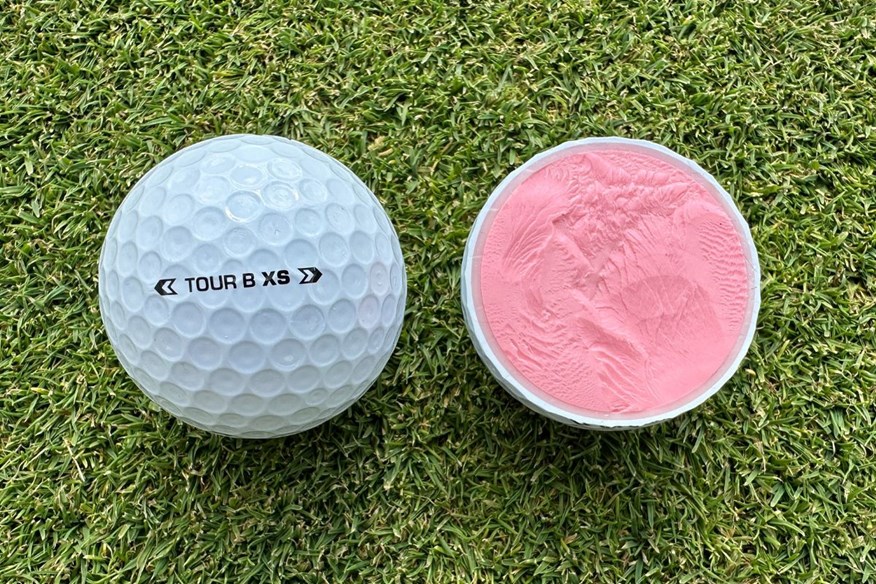
Bridgestone's Tour B XS is designed to spin higher than the Tour B X and produce a softer feeling. While our robot can't comment on the feel of this golf ball, it can tell us if it is, in fact, higher-spinning than its firmer counterpart.
Winning the silver medal for short game performance, the Tour B XS is higher-spinning around the greens than the Tour B X (6,036rpm vs. 5,972rpm). It's not drastically higher spinning, but you can expect more grab and control.
That transfers into approach play. Within the three-piece Tour-level category, the Tour B XS is the highest-spinning golf ball with over 5,000 rpm - one of only two (5,170). It's also the second-highest-spinning golf ball in the entire test.
Unfortunately, due to the dominance of the Z-Star range, the Tour B XS just misses out on a podium place for approach play performance.
Off the tee, the high-spinning nature of the Tour B XS really hurts its overall performance. At all three driver swing speeds, it ranks low, being the highest-spinning model at 78mph (second overall) and 93mph (first overall), and the second-highest-spinning golf ball at 114mph (third overall).
There'll be a lot of people put off by how much the Tour B XS spins, and it's a big reason why Tiger Woods switched to the Tour B X. However, if you struggle to generate spin, the Tour B XS is a golf ball you should definitely consider. I love it for that exact reason, and while it might not go as far off the tee, it makes up for the reduced distance by offering amazing spin and control.
On-course verdict
The Tour B XS isn’t a model found on Tour; the Tour B X is a much more popular model among the pros. For a golfer who’s looking for a soft-feeling golf ball that easily generates spin and has a driver swing speed north of 105mph, the Tour B XS is definitely a model to consider.
Some golf balls are able to work for a wide range of golfers. However, I wouldn’t say that’s the case with the Tour B XS.
As a golfer who needs help adding spin and height off the tee, the Tour B XS is a brilliant golf ball for me. I feel as though from tee to green, this ball performs incredibly well and delivers everything I need and want from a golf ball.
The Tour B XS is a soft-feeling golf ball, which I’m not normally a fan of, but I am with the Tour B XS because it’s very responsive. I think you get a lot of feedback from every shot you play with the Tour B XS.
Read our full Bridgestone Tour B XS golf ball review.
Pros
- Incredible feel and response from every shot
- Amazing spin and control around the green
- Mindset is a brilliant tool
Cons
- Not the most versatile model
| Carry distance (yds) | Driver 114mph - 268.4 | Driver 93mph - 206.7 | Driver 78mph - 160.5 | 7-iron - 153.5 |
| Ball speed (mph) | Driver 114mph - 162.7 | Driver 93mph - 133.6 | Driver 78mph - 112.8 | 7-iron - 109 |
| Backspin (rpm) | Driver 114mph - 2,964 | Driver 93mph - 3,059 | Driver 78mph - 2,795 | 7-iron - 5,170 | Pitch - 6,036 |
| Launch angle (°) | Driver 114mph - 11 | Driver 93mph - 12.3 | Driver 78mph - 13.7 | 7-iron - 20.3 | Pitch - 30 |
| Descent angle (°) | Driver 114mph - 38.6 | Driver 93mph - 33.6 | Driver 78mph - 28.4 | 7-iron - 45.2 | Pitch - 35.3 |
| Peak height (yds) | Driver 114mph - 33.1 | Driver 93mph - 22.8 | Driver 78mph - 15.8 | 7-iron - 29.1 | Pitch - 6.7 |
| Compression (psi) | 99 |
- REACTIV X System
- REACTIV iQ Smart Cover Technology
- XCLRNT mid-layer
- Gradational Core
- Dual Dimple
- Seamless Cover
- 330 dimples
- 3-Piece construction
- Available in white and yellow
- An alternative model is the Mindset
Silver medal for off-the-tee performance
The second generation of PXG golf balls are very impressive, and the Xtreme Tour X model emerged from our test as being the better-performing model compared to the Xtreme Tour. Especially off the tee, being the second-best golf ball in this category.
At all three driver swing speeds, the Xtreme Tour X is a long and fast golf ball off the tee, making it an incredibly versatile option for any golfer to consider. At 114mph, it's the third longest (272.8yds) and second fastest (164mph), at 93mph, it's the second longest (209.4yds) and second fastest (134.1mph), and at 78mph, it's the fourth longest (160.8yds) and third fastest (113mph). A seriously impressive golf ball off the tee for all golfers.
Approaching and playing around greens, you can expect a high-performing golf ball that will easily sit and grab, being the fifth-highest-spinning golf ball (4,820rpm) and having the second steepest descent angle (45.2°) from the 7-iron shot, and being the fourth-highest-spinning model (5,961rpm) with the 40-yard pitch shot.
Combine off-the-tee performance with approach play performance, and it's easy to see how the Xtreme Tour X also won bronze for tee to green performance at 114mph and 93mph.
The only issue with the Xtreme Tour X is its carry distance consistency with the 7-iron shot, ranking 46th overall. Take away the inconsistent distances when approaching greens, and you have an extremely solid golf ball that could easily have won more awards.
On-course verdict
I haven't had the pleasure of playing with the PXG Xtreme Tour X golf balls, but fellow TG Equipment Writer, Will Shreeve-Peacock, has - here's his verdict:
"As a golfer who religiously plays the Titleist Pro V1x, I was pleasantly surprised to find that the Xtreme Tour X is about as close to the real thing as I’ve seen to my go-to ball.
"While the urethane cover does feel and look slightly different, the overall feedback and performance felt instantly familiar.
"Off the face, there’s plenty of speed, but also ample spin with irons and in the short game. Around the greens and off the putter, the feel was virtually identical to the Pro V1x, soft, responsive, and confidence-inspiring. Just what I play the V1x for!
"The long-game performance impressed me the most: it feels soft off the face, launches well, and doesn’t spin up too much, addressing one of the issues I had with the original PXG Xtreme."
Pros
- Brilliant performance off the tee
- Great tee to green performance
- Amazing value
Cons
- Inconsistent distances when approaching greens
| Carry distance (yds) | Driver 114mph - 272.8 | Driver 93mph - 209.4 | Driver 78mph - 160.8 | 7-iron - 154.7 |
| Ball speed (mph) | Driver 114mph - 164 | Driver 93mph - 134.1 | Driver 78mph - 113 | 7-iron - 108.7 |
| Backspin (rpm) | Driver 114mph - 2,829 | Driver 93mph - 2,688 | Driver 78mph - 2,458 | 7-iron - 4,820 | Pitch - 5,961 |
| Launch angle (°) | Driver 114mph - 11.2 | Driver 93mph - 12.7 | Driver 78mph - 14 | 7-iron - 20.9 | Pitch - 30.2 |
| Descent angle (°) | Driver 114mph - 38.4 | Driver 93mph - 32.2 | Driver 78mph - 27.4 | 7-iron - 45.2 | Pitch - 35.3 |
| Peak height (yds) | Driver 114mph - 33.3 | Driver 93mph - 22.4 | Driver 78mph - 15.5 | 7-iron - 29.5 | Pitch - 6.6 |
| Compression (psi) | 112 |
- High-speed polybutadiene core
- lonomer mid-layer
- Soft yet durable cover
- High penetrating trajectory
- Dual Dimple
- Seamless Cover
- 338 dimples
- 3-Piece construction
- Available in white only
Silver medal for tee to green performance at 93mph and 78mph and short game performance
The Warbird Distance+ is Callaway's cheapest golf ball, but it certainly doesn't perform as though it is. This model scooped up the second-most awards in the two-piece category.
Tee to green performance is incredibly strong at all three swing speeds. The Warbird Distance+ won silver at 93mph and 78mph, and bronze at 114mph. Distance is definitely a strong factor, being the third-best golf ball off the tee in this category.
However, this golf ball isn't purely a distance model (despite it being in its name). For short game performance, the Warbird Distance+ is the second-highest-spinning two-piece model (5,963rpm) and the third-highest-spinning Callaway golf ball.
We're really impressed by the overall performance of the Warbird Distance+. It's firmly put this golf ball on our radar, and with its test results, it should be for you, too!
On-course verdict
I didn't have particularly high hopes for the Callaway Warbird Distance+ given its price, construction, and name, but I'm happy to have been proven wrong.
The Warbird Distance+ doesn't feel the greatest. It's slightly clicky and clunky, which doesn't make the feedback and response very pleasant, but if you can look past that, this is a solid golf ball from tee to green.
Despite being a distance golf ball, the Warbird Distance+ offers much more than solely distance. This golf ball produces high-spin when attacking pins with an iron and wedge - something you don't always expect from a distance golf ball, but it's always appreciated.
Although the Warbird Distance+ offers more than distance, distance is very impressive with this model, thanks to the reduced spin. The carry distance is long, but the ball continues to roll a long way, delivering amazing total distance.
The Warbird Distance+ might not jump out as a must-have golf ball, but you won't be disappointed if you give it a go - I most certainly wasn't.
Pros
- Solid tee to green performance
- Surprisingly strong short-game performance
- Impressive distance
Cons
- Not the nicest feel
| Carry distance (yds) | Driver 114mph - 270.9 | Driver 93mph - 209.2 | Driver 78mph - 161.3 | 7-iron - 157.9 |
| Ball speed (mph) | Driver 114mph - 163 | Driver 93mph - 133.7 | Driver 78mph - 113 | 7-iron - 108.7 |
| Backspin (rpm) | Driver 114mph - 2,683 | Driver 93mph - 2,611 | Driver 78mph - 2,346 | 7-iron - 4,273 | Pitch - 5,963 |
| Launch angle (°) | Driver 114mph - 11.1 | Driver 93mph - 13 | Driver 78mph - 14.2 | 7-iron - 21.6 | Pitch - 30.7 |
| Descent angle (°) | Driver 114mph - 36.8 | Driver 93mph - 32.2 | Driver 78mph - 27.3 | 7-iron - 44.9 | Pitch - 36.1 |
| Peak height (yds) | Driver 114mph - 31.7 | Driver 93mph - 22.5 | Driver 78mph - 15.6 | 7-iron - 29.9 | Pitch - 6.9 |
| Compression (psi) | 92 |
- Extra-large, high-energy core
- Hex aerodynamics
- 332 dimples
- 2-Piece construction
- Available in white and yellow
Gold medal for off-the-tee performance
Mizuno might not be a brand you consider as much when shopping for golf balls as you do when investing in a set of irons, but the Mizuno Pro X needs to be a model you bear in mind.
Of all the 3-piece Tour-level golf balls, the Mizuno Pro X is the best golf ball for off-the-tee performance based on its average ball speed and carry distance across all three driver swing speeds. The Pro X is never outside of the top 10 for off-the-tee performance out of all 62 golf balls tested.
At 114mph, this golf ball is the longest (273.5yds) and fastest (164.2mph), and it's the same story at 93mph - 210.5yds and 134.5mph. Dropping to 78mph, the Mizuno Pro X is overall the best golf ball once again, but it has to settle for second place for ball speed (113.1mph) while it continues to be the longest (161.3yds).
The Pro X performs best at a moderate swing speed. At 93mph, this golf ball won the silver medal for tee to green performance, mainly thanks to its strong performance off the tee (third overall).
According to Mizuno, the Pro X is the higher-spinning model compared to the Pro S, but both are very closely ranked in every area, and neither is particularly high or low-spinning.
If you feel as though you need some assistance off the tee, the Pro X is definitely a golf ball for you. It will add distance to your game without forcing you to sacrifice spin and control in approach play or playing around the greens.
On-course verdict
I'm a massive fan of the Mizuno Pro X. Upon reception of both models, I instantly gravitated to the Pro X because its properties align with my game more than the Pro S. The Pro X is designed to fly slightly higher, spin a little more, and deliver a firmer feel (although it’s still soft).
I genuinely find it very difficult to criticize the Pro X based on its tee to green performance. Based on my personal experience with this golf ball, it has definitely exceeded my expectations, mostly because of how strong it plays everywhere on the course.
I definitely wouldn’t class it as a firm golf ball, it’s just not as soft as the Pro S. That being said, despite it not being as firm as other golf balls I enjoy playing with, I really appreciate the feel because it's extremely responsive.
Read our full Mizuno Pro X golf ball review.
Pros
- Amazing feel and response
- Improved durability compared to previous premium range
- Incredible value for money
Cons
- Currently not represented on Tour
| Carry distance (yds) | Driver 114mph - 273.5 | Driver 93mph - 210.5 | Driver 78mph - 161.3 | 7-iron - 155.9 |
| Ball speed (mph) | Driver 114mph - 164.2 | Driver 93mph - 134.5 | Driver 78mph - 113.1 | 7-iron - 109 |
| Backspin (rpm) | Driver 114mph - 2,743 | Driver 93mph - 2,700 | Driver 78mph - 2,426 | 7-iron - 4,689 | Pitch - 5,792 |
| Launch angle (°) | Driver 114mph - 11.1 | Driver 93mph - 12.8 | Driver 78mph - 14 | 7-iron - 20.9 | Pitch - 30.5 |
| Descent angle (°) | Driver 114mph - 37.7 | Driver 93mph - 32.5 | Driver 78mph - 27.4 | 7-iron - 45 | Pitch - 35.7 |
| Peak height (yds) | Driver 114mph - 32.9 | Driver 93mph - 22.8 | Driver 78mph - 15.6 | 7-iron - 29.4 | Pitch - 6.6 |
| Compression (psi) | 116 |
- Thinner cover and thicker mantle
- High-speed ionomer mantle
- Butadiene rubber core
- Axial flow dimple design
- 332 dimples
- 3-Piece construction
- Available in white only
Gold medal for short game performance
Best two-piece short game golf ball for mid-handicappers





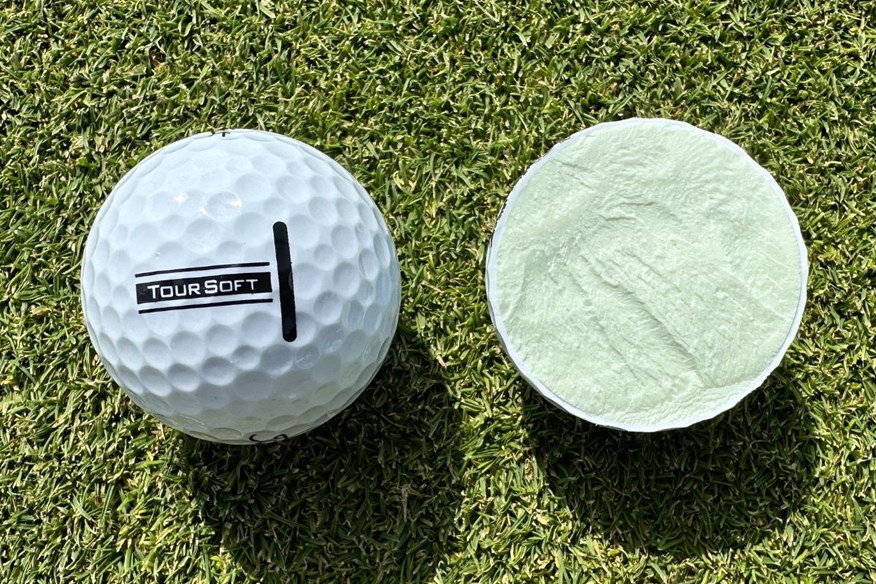
Moving to approach play, this golf ball is the bronze medal winner in this area. Tour Soft produces the second-highest spin (4,774rpm) and second-steepest descent angle (45.2), but it is the shortest two-piece golf ball (154.2yds).
Off-the-tee performance has this golf ball very closely matched with Titleist's distance two-piece golf ball - Velocity. Granted, Tour Soft is slightly shorter and slower at all three swing speeds. However, giving up less than a yard off the tee at every swing speed is probably worth it for the approach play and short game performance gains. It performed well enough at 114mph to earn the silver medal for tee to green performance.
Tour Soft is a super consistent golf ball in every area. If you're looking for a two-piece golf ball that'll do everything, this golf ball needs to be on your mind.
On-course verdict
This is one of the best-feeling golf balls I've had the pleasure of playing with purely because of how soft it is. I'm not always a fan of soft golf balls, but when they feel as good as the Tour Soft does, there's nothing to dislike.
The feedback and response throughout the bag is exactly what you want with a soft golf ball, but it's most enjoyable when playing around the greens because you can really feel the ball interacting with the grooves.
Around the greens, this ball generates amazing spin and control that's capable of challenging the best high-spin golf balls.
Moving away from the green, I didn't notice anything special about the Tour Soft's performance, but in the same breath, there's nothing to criticize. If anything, this ball performs better than you would expect from a two-piece model.
The Titleist Tour Soft is great value, and if you want a soft-feeling golf ball, this is the model you want.
Pros
- Amazing short-game spin and control
- Incredibly soft and responsive
- Great value
Cons
- Short distance in iron play
| Carry distance (yds) | Driver 114mph - 271.3 | Driver 93mph - 208.5 | Driver 78mph - 160.4 | 7-iron - 154.2 |
| Ball speed (mph) | Driver 114mph - 163.3 | Driver 93mph - 133.4 | Driver 78mph - 112.8 | 7-iron - 108.3 |
| Backspin (rpm) | Driver 114mph - 2,776 | Driver 93mph - 2,731 | Driver 78mph - 2,438 | 7-iron - 4,774 | Pitch - 6,075 |
| Launch angle (°) | Driver 114mph - 11.1 | Driver 93mph - 13 | Driver 78mph - 14 | 7-iron - 21.1 | Pitch - 30.4 |
| Descent angle (°) | Driver 114mph - 37.6 | Driver 93mph - 32.8 | Driver 78mph - 27.3 | 7-iron - 45.2 | Pitch - 35.7 |
| Peak height (yds) | Driver 114mph - 32.6 | Driver 93mph - 22.8 | Driver 78mph - 15.4 | 7-iron - 29.5 | Pitch - 6.8 |
| Compression (psi) | 95 |
- Large, faster core
- Reformulated thin fusablend cover
- Proprietary quadrilateral dipyramid dimple design
- 346 dimples
- 2-Piece construction
- Available in white, green, and yellow
- An alternative model is AIM 360
Vice's middle-of-the-road Pro series golf ball
The Vice Pro is said to sit between the Pro Plus and Pro Air in Vice's Pro range. That's exactly where the Pro sits for short game performance with 5,708rpm.
With approach play, you can expect a super consistent golf ball that you can trust to carry a similar distance shot after shot because it ranked first for carry distance consistency out of all 62 golf balls. For backspin and descent angle, the Pro is directly between the Pro Plus and Pro Air, with 4,452rpm and a 44.9° descent angle.
The same pattern appears in driving performance. The Pro is the longest golf ball of the Pro series at 93mph and 78mph, but it's in the middle of the pack when it comes to spin. However, at 114mph, it's the highest-spinning, and it's then shorter than the Pro Plus, but still longer than the Pro Air.
The Pro delivers very consistent carry numbers in approach play performance, which means it's a ball you can trust to travel a similar distance. The Pro is an inferior golf ball to the Pro Plus if you have a quick swing speed, but it's a much closer match-up at 93mph and 78mph.
Considering the Pro is Vice's challenger to the Titleist Pro V1, it's well worth giving it a go because it's nearly half the price. However, for the same price, I would suggest opting for the Pro Plus instead.
On-course verdict
I genuinely believe that Vice have missed the mark with the Vice Pro. I don’t see it offering anything more or different from the Pro Plus.
I would say that the Vice Pro performed best for me off an iron – specifically longer irons - because I knew my shot would carry and roll.
I didn’t really enjoy the feel and response of the Vice Pro, but I get that this is completely subjective! For me, there wasn’t a lot of feedback.
Between the Vice Pro Plus and Vice Tour, I think every golfer has a solid option without having to consider the Vice Pro.
Read our full Vice Pro golf ball review.
Pros
- Great value for money
- Competitive distance at varying swing speeds
- Consistent carry distance
Cons
- Limited feedback from every shot
| Carry distance (yds) | Driver 114mph - 269.8 | Driver 93mph - 208.6 | Driver 78mph - 160.7 | 7-iron - 156.9 |
| Ball speed (mph) | Driver 114mph - 163.1 | Driver 93mph - 133.6 | Driver 78mph - 113.1 | 7-iron - 108.8 |
| Backspin (rpm) | Driver 114mph - 2,829 | Driver 93mph - 2,759 | Driver 78mph - 2,499 | 7-iron - 4,452 | Pitch - 5,708 |
| Launch angle (°) | Driver 114mph - 10.8 | Driver 93mph - 12.9 | Driver 78mph - 13.8 | 7-iron - 21.3 | Pitch - 30.9 |
| Descent angle (°) | Driver 114mph - 37.4 | Driver 93mph - 32.8 | Driver 78mph - 27.3 | 7-iron - 44.9 | Pitch - 36.4 |
| Peak height (yds) | Driver 114mph - 31.9 | Driver 93mph - 22.8 | Driver 78mph - 15.4 | 7-iron - 29.6 | Pitch - 7 |
| Compression (psi) | 106 |
- Ultra-thin cast urethane cover
- Surlyn grade mantle
- Size-optimised High Energy Speed Core (HESC)
- 318 dimples
- 3-Piece construction
- Available in white and lime
- Alternative models include Drip, Shade, and Tracer
Bronze medal for off-the-tee performance
Best premium Titleist golf ball for mid-handicappers
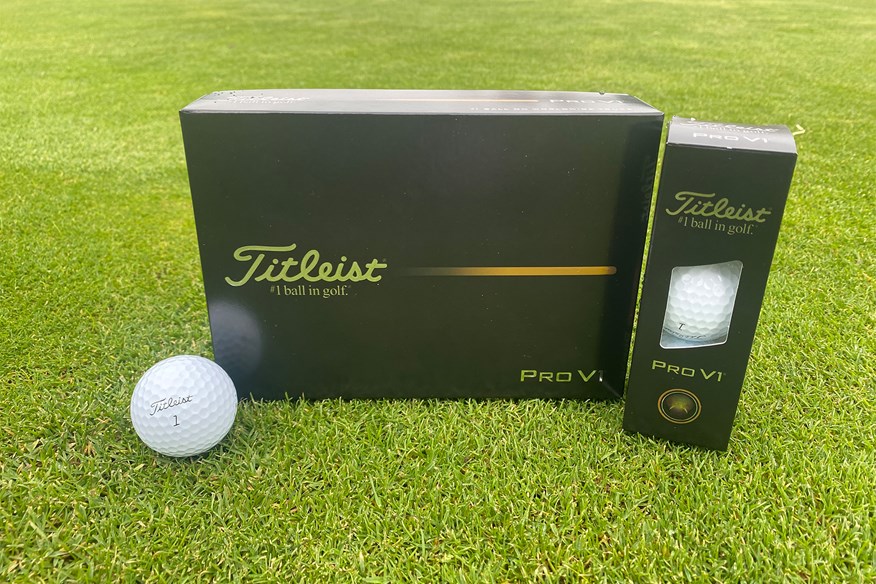

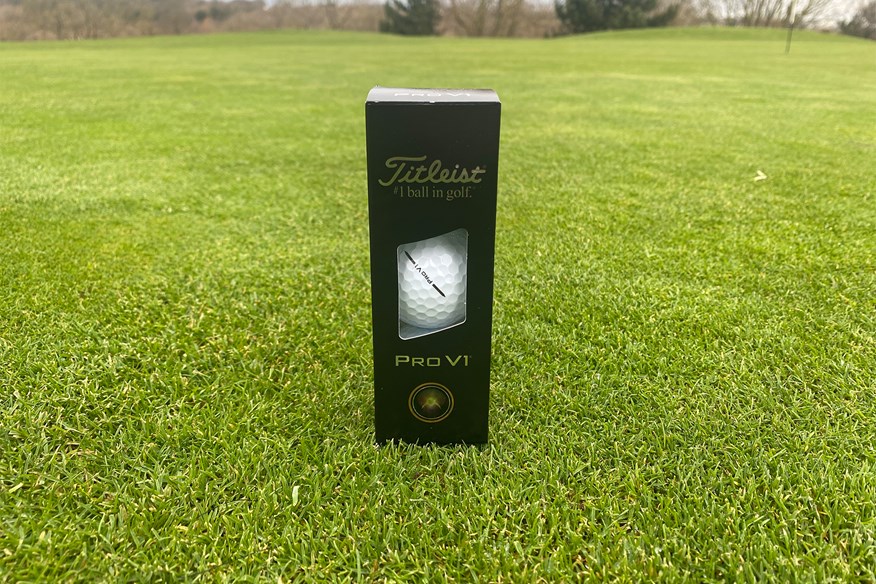



The Titleist Pro V1 is perhaps a tad unfortunate to emerge from our 2025 robot test with only a bronze medal for off-the-tee performance.
The No.1 ball in golf definitely hasn't been disgraced. It's produced extremely solid numbers across all three driver swing speeds, hence why it's the third-best 3-piece Tour-level golf ball off the tee.
At 114mph, the Pro V1 is very strong off the tee, being the second longest golf ball in this category, and one of only two 3-piece Tour-level models to deliver more than 273 yards.
It's a very similar story at 78mph. Pro V1 is the third-longest and third-fastest model in this category (0.3 yards behind the longest and 0.1mph slower than the fastest). At 93mph, Pro V1 just misses out on the podium places for carry and speed.
Pro V1 is a lower-spinning golf ball than Pro V1x, and that's exactly what our robot test results show. With the 7-iron and 40-yard pitch shots, the Pro V1 was right around the test average for backspin (4,598rpm and 5,692rpm, respectively).
Titleist Pro V1 is a golf ball for every golfer to consider, not just because it's the No.1 ball in golf, but because it suits such a wide range of golfers. It might not have scooped up tons of awards, but the data shows it's a very consistent performer that performs well in every area on the golf course.
On-course verdict
When I played the 2025 Titleist Pro V1, I experienced a striking combination of versatility, control, and responsiveness across the golf course. From tee to green, it delivers excellent distance and a penetrating, consistent ball flight, aided by a firmer high gradient core and refined dimple design.
The feel was outstanding, soft yet incredibly responsive, making every shot, from driver to putter, feel satisfying. Around the greens, I was equally impressed, short game spin and control feel heightened, helping me stop shots quickly and confidently.
Additionally, the ball’s durability has noticeably improved over previous generations - after nine holes, I didn’t feel the need to swap balls due to scuffs or wear.
Honestly, I was surprised by just how much this model exceeded my expectations. It truly performs in every area, from superb feel and responsiveness to outstanding distance control and short game precision.
Read our full Titleist Pro V1 golf ball review.
Pros
- Amazing short game spin and control
- Penetrating ball flight that optimizes carry distance
- More durable than the previous generation
Cons
- Lower short game spin than expected
| Carry distance (yds) | Driver 114mph - 273.2 | Driver 93mph - 208.7 | Driver 78mph - 161 | 7-iron - 155.3 |
| Ball speed (mph) | Driver 114mph - 163.9 | Driver 93mph - 133.8 | Driver 78mph - 113.1 | 7-iron - 108.3 |
| Backspin (rpm) | Driver 114mph - 2,684 | Driver 93mph - 2,709 | Driver 78mph - 2,525 | 7-iron - 4,598 | Pitch - 5,692 |
| Launch angle (°) | Driver 114mph - 11.1 | Driver 93mph - 12.8 | Driver 78mph - 13.8 | 7-iron - 21.1 | Pitch - 31.2 |
| Descent angle (°) | Driver 114mph - 37.2 | Driver 93mph - 32.4 | Driver 78mph - 27.5 | 7-iron - 44.9 | Pitch - 36.7 |
| Peak height (yds) | Driver 114mph - 32.4 | Driver 93mph - 22.5 | Driver 78mph - 15.5 | 7-iron - 29.3 | Pitch - 7 |
| Compression (psi) | 98 |
- Faster high gradient core
- Spherically tiled 388 tetrahedral dimple design
- Speed amplifying high-flex casing layer
- Soft cast urethane elastomer cover
- 3-Piece construction
- Available in white and yellow
- Alternative models include AIM Enhanced and RCT
No.1 3-piece club golfer model
This is one of my most highly anticipated golf balls of the entire test. Ever since I tested the Vice Tour on-course, I've been waiting to see how it would perform in our robot test. I'm very pleasantly surprised.
I'm a fan of the Tour, but I never expected this golf ball would scoop up five awards in the three-piece club golfer category. As well as being the best golf ball for tee to green performance at 114mph, the Tour won the silver medal for tee to green performance at 93mph, off-the-tee performance, and short game performance, plus the bronze medal for tee to green performance at 78mph.
This golf ball is the real deal - and it doesn't have a urethane cover. That's quite possibly a reason as to why it's low-spinning when approaching greens (4,216rpm). However, around the greens, that spin shoots up, and it's the second-highest-spinning model with 5,967rpm (14th overall).
Short game and approach play performance is very clearly solid, but off the tee is where the Tour really gets you excited. At 114mph, this is the longest (271.4yds) and second-fastest (163.3mph) golf ball, at 93mph, it's the longest (208.3yds) and third-fastest (133.4mph), and at 78mph, it's the second-longest (160.8yds) and second-fastest (113.2mph).
There's a ton to like about the Vice Tour, and factoring in the price, as well as its domination, this is the best three-piece club golfer model.
On-course verdict
I would say the Vice Tour is a suitable option for a wide range of golfers because, as a whole, it’s a decent, well-rounded golf ball.
One area where the Vice Tour impresses me is with how well it propels off the face of a long iron. Distance is strong even into the wind, and there’s a more pleasant feedback from this ball than I feel from any of the golf balls in Vice’s Pro range.
I wouldn’t go as far as to say the Vice Tour is a soft-feeling golf ball or a firm-feeling golf ball. I would place it somewhere in the middle, with a medium feel.
Having played with Vice’s Pro Plus, Pro, and Pro Air golf balls, I would say that this golf ball is more responsive than all of those. The feel off the face isn’t as profound as other golf balls I’ve played with, but it definitely isn’t as muted as other Vice golf balls.
This helps to provide more feedback from your shot, which is something I like, but it isn’t something that every golfer wants. The responsiveness of the Vice Tour could be better, but for a golf ball with a Surlyn cover, it’s pretty good.
Whether you have a fast swing speed or a slow swing speed, the Vice Tour should definitely be on your radar.
Read our full Vice Tour golf ball review.
Pros
- Consistent and tight dispersion
- Impressive on-course distance
- Incredible value for money
Cons
- Not much grab on short approach shots
| Carry distance (yds) | Driver 114mph - 271.4 | Driver 93mph - 208.3 | Driver 78mph - 160.8 | 7-iron - 158.1 |
| Ball speed (mph) | Driver 114mph - 163.3 | Driver 93mph - 133.4 | Driver 78mph - 113 | 7-iron - 108.7 |
| Backspin (rpm) | Driver 114mph - 2,769 | Driver 93mph - 2,635 | Driver 78mph - 2,381 | 7-iron - 4,216 | Pitch - 5,967 |
| Launch angle (°) | Driver 114mph - 11.1 | Driver 93mph - 13 | Driver 78mph - 14 | 7-iron - 21.5 | Pitch - 30.6 |
| Descent angle (°) | Driver 114mph - 37.7 | Driver 93mph - 32.2 | Driver 78mph - 27.3 | 7-iron - 44.6 | Pitch - 35.8 |
| Peak height (yds) | Driver 114mph - 32.6 | Driver 93mph - 22.4 | Driver 78mph - 15.5 | 7-iron - 29.6 | Pitch - 6.7 |
| Compression (psi) | 112 |
- Enhanced mid-acid Surlyn cover
- High resilience and low stiffness composition
- Size-optimized High Energy Speed Core (HESC)
- 312 dimples
- 3-Piece construction
- Available in white and grey
Best golf balls for mid-handicappers: Robot test data
View the full golf ball robot test results.
| Golf ball | Srixon Z-Star Diamond | Bridgestone e12 Speed | Srixon Z-Star XV | Srixon Z-Star | Bridgestone Tour B XS | PXG Xtreme Tour X | Callaway Warbird Distance+ | Mizuno Pro X | Titleist Tour Soft | Vice Pro | Titleist Pro V1 | Vice Tour |
| Compression | 106 | 103.0 | 112 | 92 | 99 | 112 | 92.0 | 116 | 95 | 106 | 98 | 112.0 |
| 114mph Driver Ball Speed (mph) | 163.6 | 164.0 | 163.4 | 162.7 | 162.7 | 164.0 | 163.0 | 164.2 | 163.3 | 163.1 | 163.9 | 163.3 |
| 114mph Driver Launch Angle (°) | 11.2 | 11.4 | 11.2 | 11.1 | 11.0 | 11.2 | 11.1 | 11.1 | 11.1 | 10.8 | 11.1 | 11.1 |
| 114mph Driver Backspin (rpm) | 2988 | 2680 | 2936 | 2900 | 2964 | 2829 | 2683 | 2743 | 2776 | 2829 | 2684 | 2769 |
| 114mph Driver Carry Distance (yds) | 270.7 | 273.9 | 270.6 | 269.4 | 268.4 | 272.8 | 270.9 | 273.5 | 271.3 | 269.8 | 273.2 | 271.4 |
| 114mph Driver Height (yds) | 34.5 | 33.0 | 34.0 | 33.3 | 33.1 | 33.6 | 31.7 | 32.9 | 32.6 | 31.9 | 32.4 | 32.6 |
| 114mph Driver Descent Angle (°) | 39.4 | 37.6 | 39.0 | 38.5 | 38.6 | 38.4 | 36.8 | 37.7 | 37.6 | 37.4 | 37.2 | 37.7 |
| 93mph Driver Ball Speed (mph) | 133.8 | 134.1 | 133.6 | 133.1 | 133.6 | 134.1 | 133.7 | 134.5 | 133.4 | 133.6 | 133.8 | 133.4 |
| 93mph Driver Launch Angle (°) | 12.5 | 12.9 | 12.6 | 12.6 | 12.3 | 12.7 | 13.0 | 12.8 | 13.0 | 12.9 | 12.8 | 13.0 |
| 93mph Driver Backspin (rpm) | 2838 | 2574 | 2857 | 2859 | 3059 | 2688 | 2611 | 2700 | 2731 | 2759 | 2709 | 2635 |
| 93mph Driver Carry Distance (yds) | 207.8 | 209.7 | 207.7 | 206.6 | 206.7 | 209.4 | 209.2 | 210.5 | 208.5 | 208.6 | 208.7 | 208.3 |
| 93mph Driver Height (yds) | 22.4 | 22.3 | 22.6 | 22.4 | 22.8 | 22.4 | 22.5 | 22.8 | 22.8 | 22.8 | 22.5 | 22.4 |
| 93mph Driver Descent Angle (°) | 32.6 | 31.8 | 32.9 | 32.8 | 33.6 | 32.2 | 32.2 | 32.5 | 32.8 | 32.8 | 32.4 | 32.2 |
| 78mph Driver Ball Speed (mph) | 113.1 | 113.2 | 113.2 | 113.1 | 112.8 | 113.0 | 113.0 | 113.1 | 112.8 | 113.1 | 113.1 | 113.0 |
| 78mph Driver Launch Angle (°) | 13.6 | 14.1 | 13.6 | 13.7 | 13.7 | 14.0 | 14.2 | 14.0 | 14.0 | 13.8 | 13.8 | 14.0 |
| 78mph Driver Backspin (rpm) | 2719 | 2317 | 2654 | 2693 | 2795 | 2458 | 2346 | 2426 | 2438 | 2499 | 2525 | 2381 |
| 78mph Driver Carry Distance (yds) | 161.0 | 161.3 | 160.8 | 161.1 | 160.5 | 160.8 | 161.3 | 161.3 | 160.4 | 160.7 | 161.0 | 160.8 |
| 78mph Driver Height (yds) | 15.7 | 15.5 | 15.5 | 15.8 | 15.8 | 15.5 | 15.6 | 15.6 | 15.4 | 15.4 | 15.5 | 15.4 |
| 78mph Driver Descent Angle (°) | 28.1 | 27.0 | 27.7 | 28.1 | 28.4 | 27.4 | 27.3 | 27.4 | 27.3 | 27.3 | 27.5 | 27.1 |
| 7-Iron Ball Speed (mph) | 108.7 | 109.2 | 108.7 | 108.7 | 109.0 | 108.7 | 108.7 | 109.0 | 108.3 | 108.8 | 108.3 | 108.7 |
| 7-Iron Launch Angle (°) | 20.5 | 21.3 | 20.7 | 20.8 | 20.3 | 20.9 | 21.6 | 20.9 | 21.1 | 21.3 | 21.1 | 21.5 |
| 7-Iron Backspin (rpm) | 5149 | 4467 | 4930 | 4937 | 5170 | 4820 | 4273 | 4689 | 4774 | 4452 | 4598 | 4216 |
| 7-Iron Carry Distance (yds) | 153.1 | 157.6 | 154.2 | 154.1 | 153.5 | 154.7 | 157.9 | 155.9 | 154.2 | 156.9 | 155.3 | 158.1 |
| 7-Iron Height (yds) | 29.3 | 30.0 | 29.3 | 29.5 | 29.1 | 29.5 | 29.9 | 29.4 | 29.5 | 29.6 | 29.3 | 29.6 |
| 7-Iron Descent Angle (°) | 45.3 | 45.1 | 45.2 | 45.3 | 45.2 | 45.2 | 44.9 | 45.0 | 45.2 | 44.9 | 44.9 | 44.6 |
| 40-Yard Pitch Ball Speed (mph) | 46.3 | 46.4 | 46.3 | 46.6 | 46.7 | 46.0 | 46.7 | 45.7 | 46.6 | 46.3 | 46.2 | 46.1 |
| 40-Yard Pitch Launch Angle (°) | 30.0 | 30.7 | 30.3 | 30.6 | 30.0 | 30.2 | 30.7 | 30.5 | 30.4 | 30.9 | 31.2 | 30.6 |
| 40-Yard Pitch Backspin (rpm) | 6137 | 5951 | 5948 | 5926 | 6036 | 5961 | 5963 | 5792 | 6075 | 5708 | 5692 | 5967 |
| 40-Yard Pitch Carry Distance (yds) | 39.3 | 39.8 | 39.5 | 40.1 | 40.0 | 39.0 | 40.3 | 38.7 | 40.0 | 39.9 | 39.9 | 39.3 |
| 40-Yard Pitch Height (yds) | 6.5 | 6.9 | 6.7 | 6.9 | 6.7 | 6.6 | 6.9 | 6.6 | 6.8 | 7.0 | 7.0 | 6.7 |
| 40-Yard Pitch Descent Angle (°) | 35.1 | 36.0 | 35.6 | 35.9 | 35.3 | 35.3 | 36.1 | 35.7 | 35.7 | 36.4 | 36.7 | 35.8 |
Best golf balls for mid-handicappers: Buying guide
This category of golf balls hasn’t been massively inundated until very recently. Now, mid-handicap golfers have an extensive range to choose from. Golf balls are vitally important to get right for your game to score better and improve your handicap. Therefore, I have compiled a list of key factors to consider when purchasing golf balls.
Budget
The majority of amateur golfers will not need to play with a four- or five-piece golf ball, partly because of ability, but also because of price. I have included a couple of premium options if you do have the budget, but if you don’t want to pay more than $50, you don’t have to. Obviously, if you do want to play with a premium golf ball or a four- or five-piece golf ball, I won’t stop you!
Performance
With the golf ball rollback coming into force in the not-too-distant future, performance has never been more important! If you want to make sure you have a ball that travels as far as possible, it’s worth stocking up now before it’s too late.
Every golf ball performs slightly differently, and only through trying a range of golf balls will you find the best golf balls for your game. If you are playing with the wrong golf ball, you’ll know by how far the ball is going, how high the ball’s flying, how much the ball’s spinning, etc. When you find the perfect golf ball, you’ll know.
Feel
This is a factor most amateur golfers won’t even need to consider. Many regular golfers know exactly what type of ball they are looking for with regard to feel. There are both soft-feeling and firm-feeling golf balls for mid-handicap golfers to choose from. I personally prefer a firmer golf ball because I like the stronger feedback off the clubface. However, I know I’m in the minority there because the vast majority of golfers would rather play with a soft golf ball.
There isn’t a right or wrong answer when it comes to feeling; it’s all about finding the right ball for you, and then you just have to hope that it feels good to play with.
Spin
Ideally, every golf ball would produce low-spin off the tee and high-spin in your approach game. However, not all golf balls are designed that way. The majority of golf balls are designed to produce low driver spin and generate distance off the tee, but not all golf balls are manufactured to generate high spin from irons and wedges.
Price generally correlates with short-game spin. Budget golf balls will generate less short-game spin than expensive golf balls, but there might not be much difference in your long-game spin. During a ball fitting at Titleist, I discovered that a Titleist Pro V1x and Titleist Velocity performed very similarly with my driver, but with a 7-iron, the spin dropped slightly with the Velocity, and then with a 60° wedge, the spin fell massively with the Velocity.
Spin in the golf ball comes from the combination of layers within the golf ball reacting with one another, hence why more expensive golf balls spin more in approach play because they consist of more layers and the technology is more refined. Cheaper golf balls tend to consist of two layers: the cover and core. Therefore, they don’t have the number of layers required to produce astronomical spin when attacking pins.
Another factor that helps to enhance spin is the cover material. Golf balls with a urethane cover tend to spin more (but not always) because it’s a more flexible material compared to ionomer or surlyn, which doesn’t create as much friction with the clubface as urethane does. Once again, it’s more expensive golf balls that feature urethane covers to generate higher spin on approach shots.
Spin is massively important because it can either make you hit and hold a green or hit and fly over the green. The best golf balls for spin are by far premium golf balls, closely followed by golf balls for mid-handicappers, because they feature much of the technology found in Tour-standard golf balls. If you feel as though you need high levels of spin when attacking greens, have a look at the best high-spin golf balls. Alternatively, if you feel as though spin is hurting your game, check out the best low-spin golf balls.
Distance
I would honestly say that distance is the last factor to consider when purchasing golf balls. The best way to figure out which golf balls are best for you is by working your way back from the green to the tee box. The best way of doing this is with a launch monitor to see your numbers, but if you don’t have access to one, you can do it with your eye very easily.
Start by hitting wedge shots into the green and see which balls are performing best with spin, then work your way back to 7-iron distance and look for the same numbers with slightly more of an eye on carry distance. You should have whittled it down to one or two golf balls, hit them off the tee, and look at which performs the best.
If you do it this way, I guarantee a premium golf ball will always come out on top if you’re testing one. However, if you’re doing this with cheaper golf balls, you’ll still see differences between the golf balls, and you will find one that performs well for you, or you might have the luxury of deciding between a handful.
By testing golf balls this way, you’ll end up with the ball that performs best in the short game, which is where you score. Distance is important, but there are other ways of improving distance without sacrificing spin in a golf ball.
Alignment
Alignment golf balls are becoming increasingly popular because they offer golfers extra assistance to help them line the ball up with their intended target. These alignment aids differ in size and style in order to appeal to more golfers. The majority of alignment golf balls do come without alignments as well, but there are some that don’t.
Color
The most common golf ball color is white; however, there are plenty of other colors and designs to choose from. More vibrant colors, such as yellow, orange, or green, are all easy to pick up, and they help some people with visibility – hence why they make for the best winter golf balls.
Other ways of adding color to the golf ball can be by design, whether it be a splash of color seen on Vice golf balls or an alignment design which also helps with visibility, such as TaylorMade’s Pix golf balls or Callaway’s Triple Track golf balls.
If you’ve only ever played with white golf balls, it might be worth trying a more colorful golf ball, especially if you’re always the one asking your playing partners, “Where did that one go?”.
Best golf balls for mid-handicappers: FAQs
What to read next
For performance insights tailored to your swing speed and preferences, head to our results hubs:
- Best 4 and 5-piece golf balls
- Best 3-piece golf balls
- Best 2-piece golf balls
- Best golf balls for fast swing speeds
- Best golf balls for average swing speeds
- Best golf balls for slow swing speeds
- Best golf balls for distance
- Best golf balls for approach play
- Best golf balls for short game
- Best golf balls for beginners
- Most consistent golf balls

